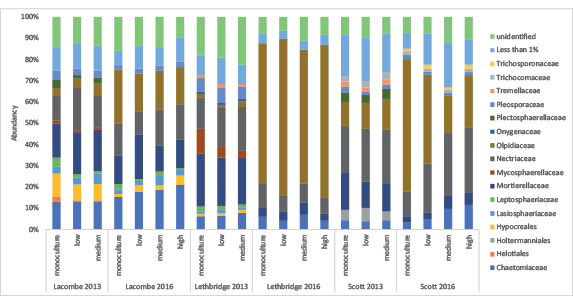Root and rhizosphere microbiota vary by crop and conditions
Key result:
Biodiverse agricultural systems improve agricultural productivity and climate management. This study contributes to a better understanding of canola microbiota, which provide important information to improve canola yields and reduce greenhouse gas emissions by identifying crop rotations that could potentially reduce nitrogen fertilizer use.
Project title, principal investigator:
“Enhancing the beneficial root microbiome in canola” Chantal Hamel, AAFC Swift Current
Funding:
SaskCanola, Alberta Canola, Manitoba Canola Growers, Natural Sciences and Engineering Research Council of Canada
Full report:
To find the full report and list of peer-reviewed publications with articles on this work, go to the Canola Research Hub at canolaresearch.ca and search for the project title.
This project demonstrated that biodiverse agricultural systems improve agricultural productivity and climate management. The challenge in employing microbiome technologies for improving agricultural systems is the pre-requisite of understanding how soil microbial communities are structured. The study contributed to a better understanding of canola microbiota, providing information to improve canola yields and reduce greenhouse gas emission by identifying the best rotation system that could potentially reduce nitrogen fertilizer use.
The objective of this project was to assess the consistency and variability in the composition of the canola core rhizospheric and root microbiota, and determine crop rotation systems that best favour a beneficial root microbiome in canola. Researchers also investigated crop rotation systems that possibly increase canola productivity while allowing the reduction of fertilizer and pesticide use.
Researchers tested two parameters of this process: the role of soil history in environmental filtering, and the selection pressure created by host plants. They also described the impact of five Brassicaceae plants and their soil history on the structure of bacterial communities in their rhizosphere and roots. It was determined that soil history was significant in structuring the bacterial communities when soil chemistry was highly significant under possible drought conditions. Second, that the Brassicaceae host plants (Brassica napus, B. carinata, B. juncea, Sinapis alba and Camelina sativa) were consistently significant in structuring the bacterial communities.
Results
- Canola microbiomes were documented for three communities of microorganisms: bacteria, fungi and archaea.
- Canola root and rhizosphere microbiomes were significantly different from those of wheat and pea.
- The research team highlighted the potential PGPR (plant growth-promoting rhizobacteria) among those microorganisms by correlating the core microbiome members in the Canadian Prairies
with canola yield. - Fertilization and seeding rates seem to influence certain taxa forming the core and eco microbiomes of canola based on the relative abundances profiles, notably the parasite Olpidium brassicae, which was less abundant at the higher seeding rate.
- Certain archaea showed some specificity to crops and treatments. Furthermore, the putative interactions between members of bacterial and fungal core microbiomes were weaker with higher fertilization and seeding than with the recommended treatments in canola rhizospheres.
- Lentil substantially increased biological nitrogen fixation and reduced denitrification in the following oilseed crops.
- Most nitrogen-cycling gene transcripts are more abundant in the microbiomes associated with roots than with the rhizosphere.






